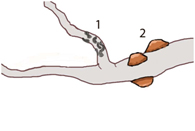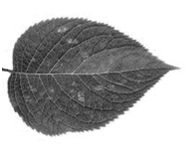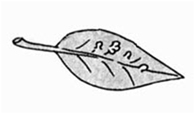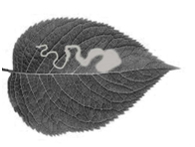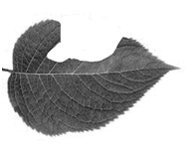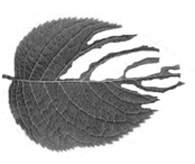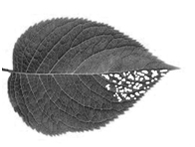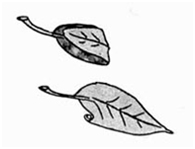What does the leaf damage look like?
| No sign of distinct holes or chewing damage | Continue... | |
| Distinct signs of chewing damage or holes of some type | Continue... | |
No sign of chewing damage
Leaves cupped, wilted, wrinkled, sticky, have many fine white to yellow spots or a scorched appearance.
These signs may be caused by any of a variety of sucking insects such as aphids, leafhoppers, plant bugs, scales, or mites.
| Soft-bodied insects in distinct clusters or colonies on new leaves; large volumes of a sticky honeydew waste that can give leaves a shiny appearance or result in growth of dark sooty mold |
APHIDS | |
| Small, elongate insects that jump, move quickly or fly when disturbed. They cause fine white spots on leaves as they feed. Common on redbud in late summer. | LEAFHOPPERS | |
| Are common on the lower surface of sycamore and azalea in mid- to late summer. They give leaves a bleached look and leave tarry black waste spots. | LACE BUGS | |
|
Flattened, oval insects. They can distort leaves of honeylocust or produce a series of small brown spots on leaves.
|
PLANT BUGS | |
Found on trees and woody ornamentals. Some are flat and blend in with the bark, others are very distinct. Unlike galls, scales can be scraped off leaves or bark. Heavy infestations can cause twig dieback.
|
SCALE INSECTS | |
Feed on the lower surface of leaves giving the leaves a bleached look. Mites are very small and easy to overlook.
|
MITES | |
| Maple leaves with partial petioles on ground | MAPLE PETIOLE BORER | |
Warts, bumps, or fuzzy patches on leaves, petioles or twigs that cannot be removed without tearing plant tissue. may be caused by tiny wasps, flies, or mites
|
GALLS | |
Pale or dark blotches on leaf; winding trails or blisters; larva may be present
|
LEAFMINERS | |
Chewing damage or holes present
| Leaves look ragged or chewed; large sections of leaf material missing | Continue... | |
| Pairs of holes equidistant from a major vein – in early spring | FROST BUD INJURY | |
| Leaves chewed only on one surface but no complete holes | Continue... | |
| Leaves held together with silk | Continue... | |
Large sections of leaves missing
Entire leaves chewed away or holes in leaves; larger veins may be intact; leaf material removed in a methodical way
|
Common leaf feeders: BEETLES such as Japanese beetles, May beetles, leaf beetles, or chafers CATERPILLARS, INCHWORMS or HORNWORMS - worm-like larvae with 4 or fewer pairs of fleshy legs on middle of body SAWFLIES- worm-like larvae with more than 5 pairs of fleshy legs LEAF BEETLE LARVAE- worm-like but without fleshy legs BAGWORMS or CASEBEARERS - worm-like larvae in silken bags or cases; pieces of leaves may be attached |
|
| Leaves ragged and torn, usually without distinct holes or with random chunks missing | WIND DAMAGE | |
Leaves chewed on only one surface
Leaves chewed only on one surface but no complete holes; small veins and one leaf surface intact (small caterpillars or slug-like leaf skeletonizers)
|
Early feeding by most small caterpillars begins as skeletonization OAK SLUG SAWFLY LARVAE feed on the upper surface of oak leaves PEAR SLUG SAWFLIES feed on the lower surface of pear, cherry and plum. ROSESLUG SAWFLIES feed on the lower surface of roses. ELM LEAF BEETLE LARVAE are dark colored and feed on the lower surface of elms. |
Leaves held together with silk
| Groups of leaves webbed together with or covered with silk | WEBWORMS or TENT CATERPILLARS | |
Individual or adjacent leaves rolled, creased or folded, may be held together with silk
|
LEAFROLLERS | |

